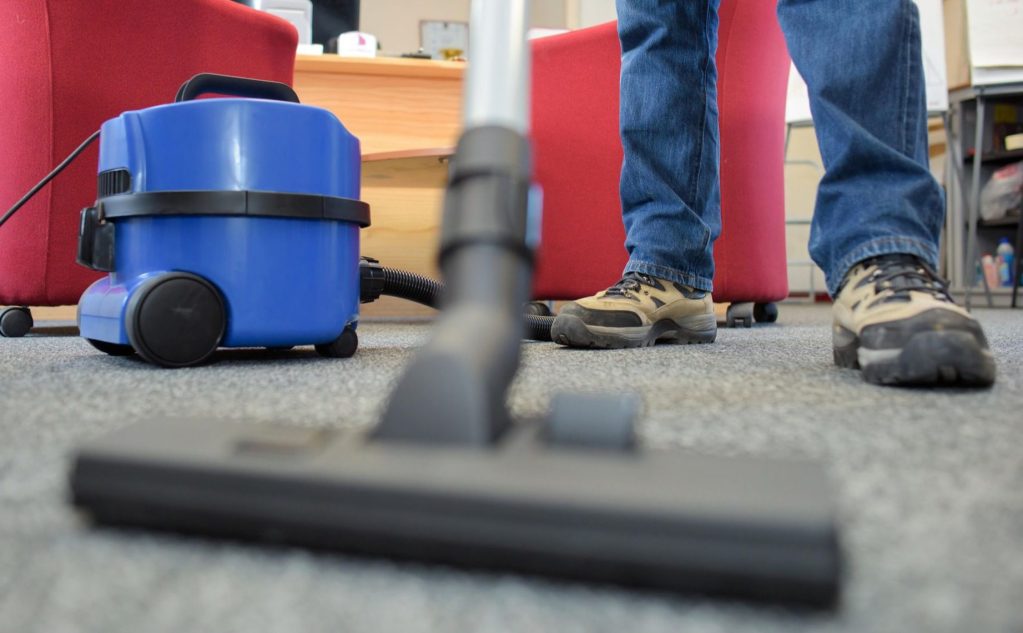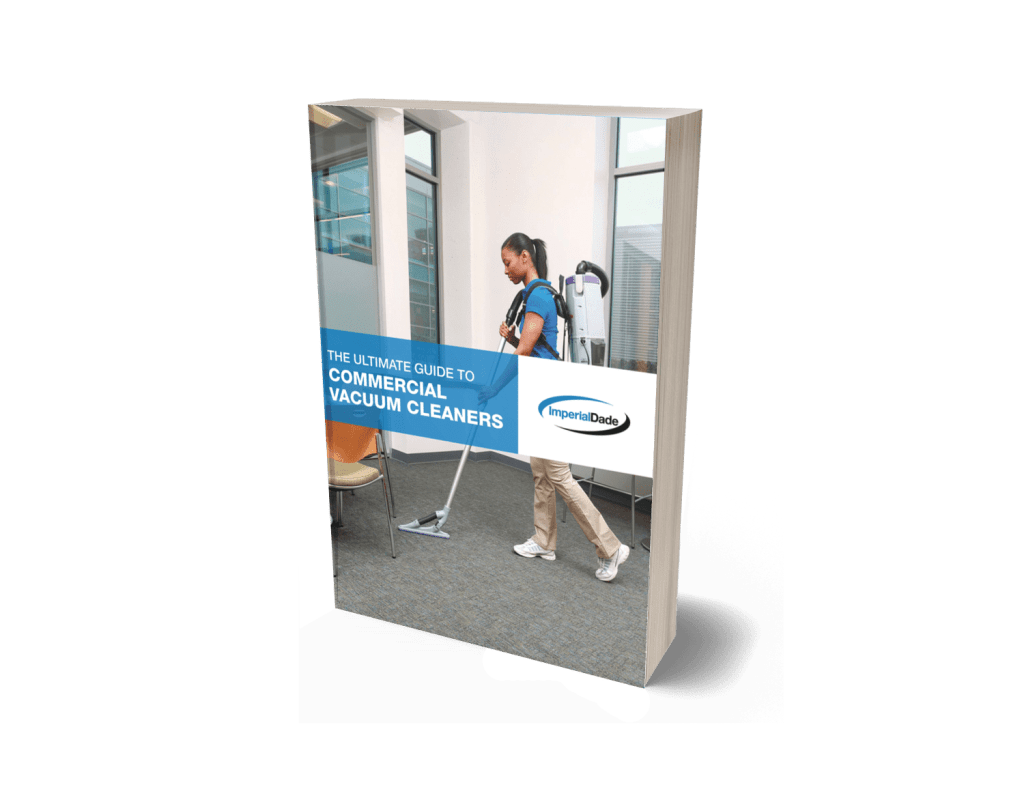Do you have the most efficient vacuum for your commercial hard flooring? Hard floors require additional attention when vacuuming to ensure that all dust and dirt particles are removed without damaging the floor.
The best vacuum for hard floors is different from the best option for carpeted floors.
So, what is the best vacuum for hard floors?
When selecting the best vacuum for the hard floors in your facility, you’ll need to evaluate the machine based on 7 key factors:
- Vacuum Type
- Power Source
- Size & Maneuverability
- Availability of Specialized Attachments
- Brush Type
- Static Lift & Airflow
- Filtration System
Each of these factors will play a role in the success of your vacuuming procedures on hard floors.
Below we’ll review how each of these factors can affect your hard floor vacuuming procedures and what specifically you should be looking for to achieve the best results.
1. Vacuum Type
There are five main types of vacuum cleaners:
- Handheld Duster Vacuum Cleaners
- Canister Vacuum Cleaners
- Upright Vacuum Cleaners
- Backpack Vacuum Cleaners
- Wet/Dry Vacuum Cleaners
Handheld duster and wet/dry vacuums are specialized machines that tackle unique cleaning tasks.
While canister and backpack models are generally accepted for daily vacuuming of hard floors we recommend the use of backpack vacuums.
Backpack vacuums are lightweight and more versatile than other types of vacuums like uprights or canisters.
Canister vacuums are bulky and can take up a lot of space. They also have long hoses and cords which can get caught on items. It is likely you’ll see more damage to furniture and surrounding objects with canisters than you would with a backpack vacuum.
Canisters also have wheels which increase the amount of drag on a machine. The more drag, the more effort the operator will have to expend to move the machine, which will increase worker fatigue.
Upright vacuums can be used to vacuum hard floors but are not as productive as backpack vacuums.
For example, it typically takes about 3 hours and 20 minutes to vacuum 10,000 sq. ft. of carpet using a standard upright. However, with a cordless backpack vacuum, it only takes about 1 hour and 20 minutes, saving your staff 2 hours each cleaning shift*.
Upright vacuums typically have a brush roll which can kick up dirt and scatter it across the floor, making more work for your staff.
2. Power Source
To vacuum hard floors, battery powered or cordless vacuums will provide your staff with the greatest productivity.
They will allow your staff to experience a 30% increase in productivity when compared to corded electric backpack vacuums.
This is because your staff will not have to worry about the cord.
Cordless machines give the operator freedom of motion. They are free to move beyond the length of a typical cord, and they do not have to stay within reach of an outlet at all times.
Additionally, there is no risk of your employees or other building occupants tripping on the cord.
Finally, your staff will have the ability to safely clean stairs and landings.
3. Vacuum Size & Maneuverability
Maneuverability is key when it comes to finding the best vacuum for hard commercial flooring. The size of your vacuum will play a large role in vacuum maneuverability.
Maneuverability refers to the vacuum’s ability to quickly fit into tight spaces or under and around furniture.
This is essential to helping your staff quickly complete cleaning procedures.
For example, big bulky canisters will be hard to move and will require extra time and effort from your staff. Similarly, upright machines will only be able to fit into areas larger than the head of the machine.
The easiest vacuums to operate are backpack vacuums. They do not take up any floor space, reducing the chance of bumping into items and damaging them.
The faster your cleaning team can vacuum the area, the more efficient they’ll be during their entire cleaning shift.
4. Availability of Specialized Attachments
Attachments are important to helping vacuums become more versatile.
Each type of attachment has a benefit that allows the user to become more efficient and effective at vacuuming.
Tools can help your staff:
- Reach into tight crevices
- Reach above the floor surfaces
- Offer safer attachments for easily damaged floor types
- Accommodate different size areas
Backpack vacuums can be paired with multiple different types and size cleaning tools.
The variety of attachments make backpack vacuums extremely desirable for facilities that will be cleaning different areas with the same piece of equipment.
5. Brush Type
When dealing with commercial hard floors, you will not need a vacuum with a brush roller. Rollers are typically only needed to clean carpet.
The bristles on brush rollers are stiff and designed to pick up dirt from deep within carpet fibers but can actually scratch hard flooring.
Depending on your hard floor type, you may need a felt tip brush to ensure that your hard floor does not get scratched or damaged by hard brush bristles. Felt brushes are softer and designed to remove dust and debris without scratching the floor surface.
Aside from damaging floors, brush rollers are also more likely to increase debris scatter on hard floors.
However, if your hard floor is grouted, you may need a vacuum tool with bristles to collect dirt from the grout.
If you will be dealing with multiple floor types, a vacuum with an adjustable brush roll will be most efficient.
Adjustable brush rolls allow the height of the bristles to be manually or automatically adjusted based on the floor type and floor height to ensure they make optimal contact with the floor.
6. Balanced Static Lift & Airflow
To remove dirt from the floor, vacuums use a combination of static lift and airflow.
The suction required to remove dirt from a carpet is not the same as hard flooring.
You’ll want to make sure that the vacuum offers enough suction to capture dirt and debris without scattering it over a wider surface.
This will require you to look for a balanced combination of static lift and airflow.
What is static lift and air flow?
Static lift and airflow work together. Static lift removes the soil from the surface and airflow helps the dirt and debris travel down the vacuum hose to the tank. Static lift measures the strength, or how much soil the vacuum can pull from the surface. The higher the static lift, the more dirt, and debris the vacuum will be able to remove. Static lift is typically between 60 and 100 inches.
Airflow is the amount of air the vacuum moves through the hose per minute. This feature is what moves the dirt and soils through the vacuum hose to the tank. Airflow generally ranges between 95 and 150 CFM.
7. Filtration System
When vacuuming, dust and dirt particles are drawn into the vacuum but can sometimes be pushed up into the air by the vacuuming motion. Additionally, micro particles can be put back into the air after being filtered by the vacuum.
A good vacuum will limit the number of particles let back into the air. This is especially important on hard floors because of the increased likelihood of the particles leaving the floor.
Carpeting is more likely to trap and contain dust and dirt. However, when vacuuming hard floors, the particles can easily be pushed up into the air.
HEPA filtration is one of the most highly sought filtration systems.
HEPA (High Efficiency Particulate Air) filters are able to trap 99.97% of particles that are 0.3 microns or larger. HEPA filters prevent contaminants and other impurities from being released back into the air flow.
Lowering the amount of impurities in the air will improve indoor air quality (IAQ).
Final Thoughts
Regardless of the type of hard flooring you currently have, carefully using the above features to choose a vacuum will help ensure you are providing your staff with the machine that will allow them to vacuum most efficiently and effectively.
We recommend the use of backpack vacuums on hard floors.
They are the most efficient and will allow your janitorial staff to enjoy a range of benefits including increased range of motion, improved safety, reduced fatigue, and improved ergonomics that ultimately allows them to complete more work in less time.
You’ll also want a vacuum with good static lift and air flow as well as HEPA filtration to limit the amount of particles that can escape the vacuum and help improve indoor air quality (IAQ).
Brush rollers, typically found on upright vacuums, can also increase the amount of debris pushed into the air.
Imperial Dade locations have a wide variety of commercial vacuums that function well on commercial hard floors. If you’re located in the United States, Puerto Rico, or the Caribbean, contact an Imperial Dade Specialist for help identifying the best vacuum for your unique business needs.
Visit our equipment page to learn more about our equipment offering, request pricing info, demo some of our best hard floor vacuums, and more.
*according to ISSA 612 Cleaning Times

